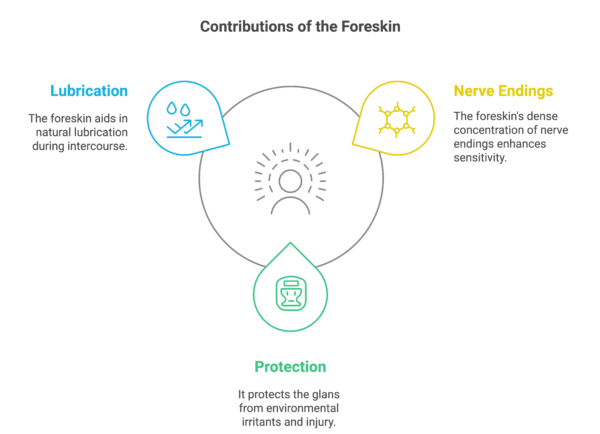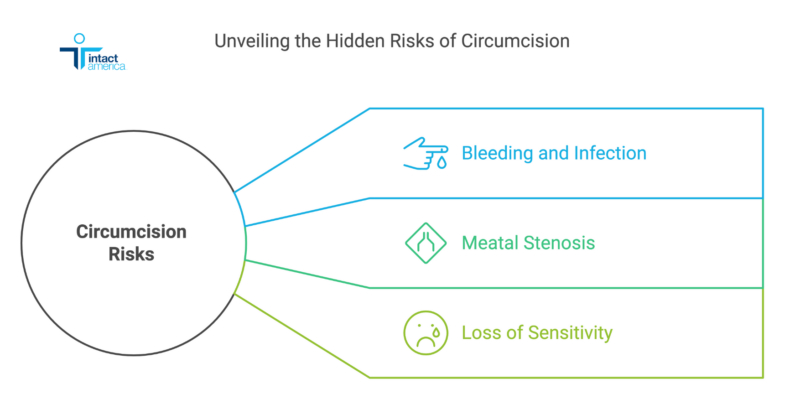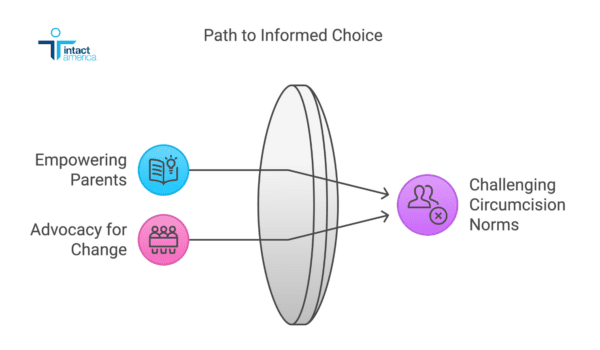
Circumcision is sold as the ultimate quick fix—a one-snip solution for hygiene and health. But the reality is far murkier and more unsettling than the glossy narrative would have you believe.
This irreversible surgery, performed mostly on infants who can’t consent, removes a functional, sensitive part of the body for reasons rooted more in tradition, cultural inertia, and misinformation than in sound science.
It’s high time we confronted the myths, the ethics, and the raw data surrounding circumcision. The question looms large: why are we still doing this?
What Is Circumcision Really, and What’s Being Taken Away?

Let’s start with the basics: circumcision is the surgical removal of the foreskin, the protective sheath of skin that covers the glans (head) of the penis. But don’t be fooled by the sanitized language. This isn’t just a “snip” or the removal of “extra” skin. The foreskin is a complex, highly specialized tissue that plays a significant role in sexual function and overall penile health.
Packed with thousands of nerve endings—some estimates range from 10,000 to 70,000—the foreskin is one of the most sensitive parts of the male body. It also serves to protect the glans, keeping it naturally lubricated and shielded from environmental irritants. Without it, the glans becomes keratinized, losing its natural sensitivity over time.
Dr. Paul Fleiss, a pediatrician and staunch critic of circumcision, famously said that the foreskin is not a birth defect; it’s a normal, sensitive, functional part of the body” Yet in the United States, the CDC reports that over 60% of newborn boys are still circumcised annually. That’s millions of infants each year losing a vital part of their anatomy—not because of medical necessity, but because of cultural momentum and outdated beliefs.
What Are We Losing?
The foreskin contributes to sexual sensation, natural lubrication during intercourse, and overall penile health. Removing it is akin to robbing men of their full sexual potential before they even have a say.
Debunking the Health “Benefits”
Proponents of circumcision love to tout its supposed health benefits, but the data doesn’t hold up under scrutiny. The arguments are often cherry-picked, misleading, or downright outdated. Let’s dismantle the most common claims:
1. Urinary Tract Infections (UTIs)
❌ The claim: Circumcision significantly lowers the risk of UTIs in infants.
✅ The truth: While there is a slight reduction in UTI risk for circumcised infants, the numbers hardly justify surgery. UTIs are already rare in boys—occurring in only about 1% of uncircumcised infants. When they do occur, they’re easily treated with antibiotics, rendering surgery an excessive and unnecessary intervention.
A study in The Canadian Urological Association Journal revealed a staggering statistic: over 100 circumcisions would need to be performed to prevent a single UTI. This disproportionate approach not only introduces unnecessary surgical risks but also ignores less invasive solutions. Altering the anatomy of 100 boys to address an easily manageable condition? The math—and the ethics—don’t add up.
2. Sexually Transmitted Infections (STIs)
❌ The claim: Circumcision reduces the risk of contracting HIV and other sexually transmitted infections.
✅ The truth: This argument is rooted in studies conducted in sub-Saharan Africa, where HIV transmission rates are high and access to condoms and healthcare is limited. In such regions, circumcision may offer a slight reduction in HIV transmission. However, in countries with widespread access to condoms, education, and preventive healthcare, the protective effect is negligible.
A Lancet meta-analysis confirmed this, emphasizing that safe sex practices like consistent condom use are far more effective at preventing HIV and STIs. They also come without the risks, pain, or permanent changes associated with circumcision. For low-risk populations, surgery is an unnecessary and outdated solution to a problem that modern prevention has already addressed.
3. Penile Cancer
❌ The claim: Circumcision protects against penile cancer.
✅ The truth: Penile cancer is one of the rarest forms of cancer, with an occurrence rate of about 1 in 100,000 men in developed nations. Its rarity alone makes circumcision a wildly disproportionate preventive measure. Moreover, risk factors like smoking, poor hygiene, and HPV infections play a far greater role in its development than the presence of foreskin.
Circumcision is not recommended as a method of cancer prevention. Promoting circumcision as a safeguard against such a rare condition is akin to performing unnecessary surgery for the slimmest of possibilities—a solution in search of a problem.
The Ethical Time Bomb
If circumcision were introduced today, it would be seen as a grotesque violation of human rights. Why? Because it’s done without consent. Infants and young children cannot consent to a surgery that permanently alters their bodies. Period.
If parents opted for unnecessary cosmetic surgeries on babies—nose jobs, ear tucks, or anything else deemed “aesthetic.” Society would explode in outrage. Yet circumcision, which removes a functional, sensitive part of the body, is not only accepted but encouraged.
The Right to Bodily Autonomy
The United Nations Convention on the Rights of the Child explicitly states that children have the right to protection from practices that harm their health. Activists argue that circumcision violates this principle. Dr. Brian Earp, a leading bioethicist, argues, “No other medically unnecessary surgery would ever be performed on a non-consenting child.”
This is what makes circumcision so ethically indefensible: it robs individuals of their right to make decisions about their own bodies.
The Risks No One Talks About

Circumcision is often marketed as “low-risk,” but complications can and do happen—and the consequences can be severe:
a. Bleeding and Infection: According to a study in the Journal of Pediatric Surgery, up to 5% of circumcisions result in complications, including severe hemorrhaging or infections.
b. Meatal Stenosis: This narrowing of the urethral opening occurs in up to 10% of circumcised boys and often requires additional corrective surgery.
c. Loss of Sensitivity: Circumcision removes some of the most sensitive tissue on the male body, leading to a noticeable reduction in sexual sensation.
Parents are rarely informed about these risks. The narrative focuses on benefits while sweeping potential complications under the rug.
Tradition vs. Autonomy: Cultural and Religious Roots
Circumcision has long been cloaked in the armor of culture and religion, hailed as a sacred rite of passage or a divine covenant. But let’s be real: no tradition, no matter how ancient, justifies permanently altering someone else’s body without their consent. Cloaking a violation of bodily autonomy in the guise of “heritage” doesn’t make it less invasive—it makes it more insidious. Respect for culture can never come at the expense of an individual’s right to decide what happens to their own body.
Time to Rethink Tradition
In forward-thinking countries like Sweden and Germany, circumcision is increasingly viewed through the lens of human rights. With low circumcision rates, these nations are pushing the conversation toward alternatives that honor cultural and religious values without requiring a blade. Many religious communities are embracing symbolic ceremonies, proving that tradition doesn’t need to leave scars—literally or figuratively.
A Global Divide
Circumcision rates vary wildly around the world. In the U.S., circumcision has been normalized due to outdated medical practices and cultural momentum. In contrast, European countries like Finland and Denmark boast circumcision rates below 10%. Their health organizations prioritize education about hygiene over unnecessary surgical intervention.
The Way Forward: Challenging the Status Quo

Why does circumcision persist? Inertia. Misinformation. Cultural pressure. But this cycle can be broken.
Empowering Parents
Parents need access to accurate, unbiased information about the foreskin’s function and the realities of circumcision. Medical professionals must stop promoting outdated narratives and instead focus on informed consent.
Advocacy for Change
Organizations like Intact America fight to educate the public and challenge societal norms. Their work is essential in shifting the conversation from blind acceptance to critical examination.
Conclusion: The Cut Stops Here
Circumcision is an outdated practice based on shaky evidence. The supposed health benefits don’t outweigh the risks, the ethics are indefensible, and the impact on bodily autonomy is undeniable.
The foreskin isn’t the problem. The system that normalizes cutting it off is. It’s time to stop letting tradition, misinformation, and cultural inertia dictate decisions about children’s bodies. The choice to remove a part of the body should belong to the person living in it—not parents, not doctors, and certainly not society.
Let’s leave this antiquated practice where it belongs: in the past.






Wendy
January 10, 2025 1:27 amThanks for the update! This legal form of child abuse is way wrong and women need to be educated. The thing I am most disturbed over is how in heck is the bond between mother and child broken? I have no children, but in nature does any other mother allow harm to their young? I have made a group on Facebook “uncut” and plan to beg mother’s for an answer..Wendy
Dave
August 26, 2025 12:50 amI’m totally disturbed that a cosmetic company/corporation could convince themselves and others to pilfer a baby’s foreskin for a beauty product and get away with it. Who in their sick mind would dream this shit up? How morally deprived can humans become? I personally don’t think humans will be around for much longer. It’s like a parasite has taken over humanity and made a mockery of everything.
Garrison
September 16, 2025 10:27 amOne thing intactivists have not gotten, you will never end this with pain arguments, they don’t care. You will never end it without targeting those who make this a free offer, Medicaid, and most insurance. And finally, look who sells it and who makes the illusion that its a normal, natural expectation for boys in US and invents stupid excuses such as looks like Daddy.